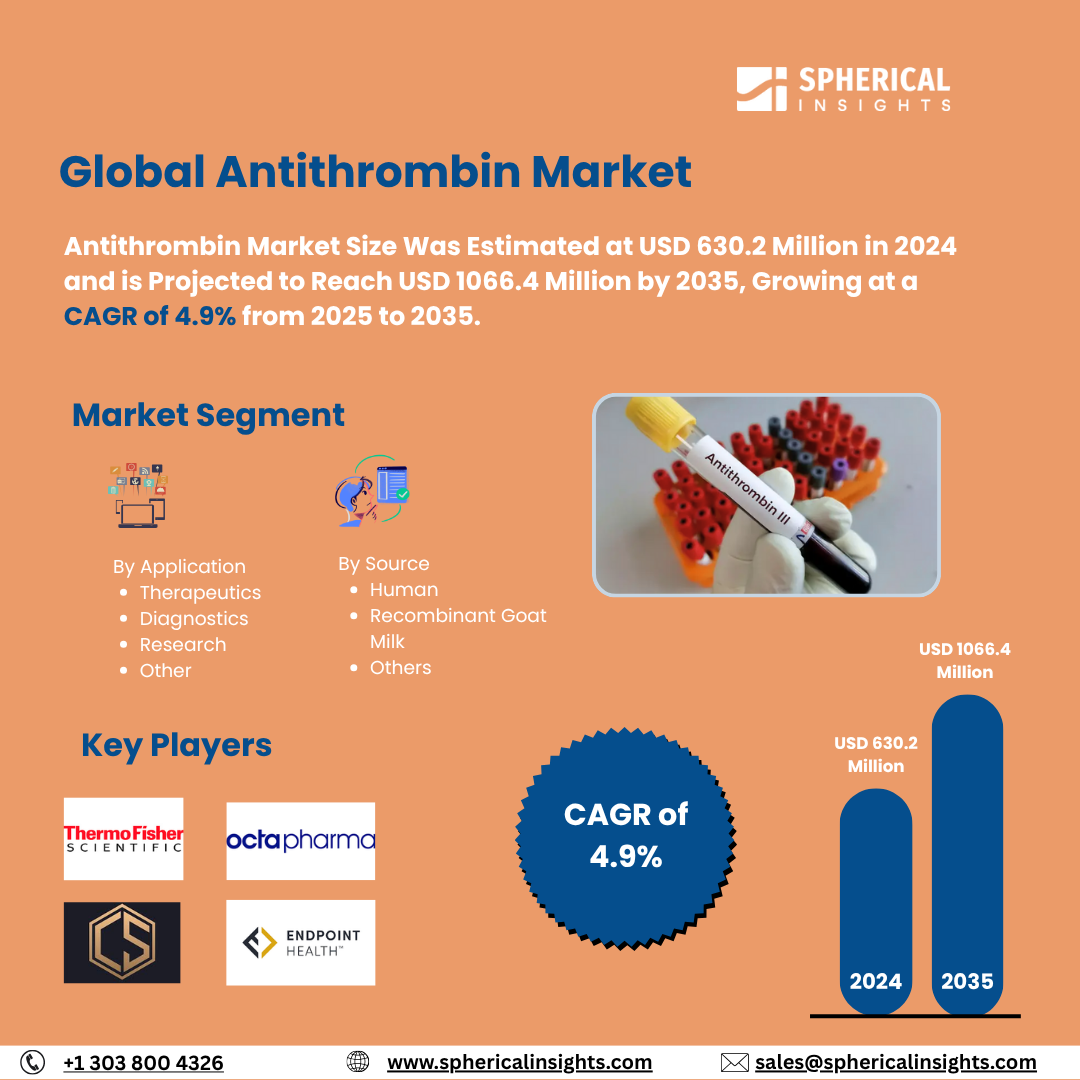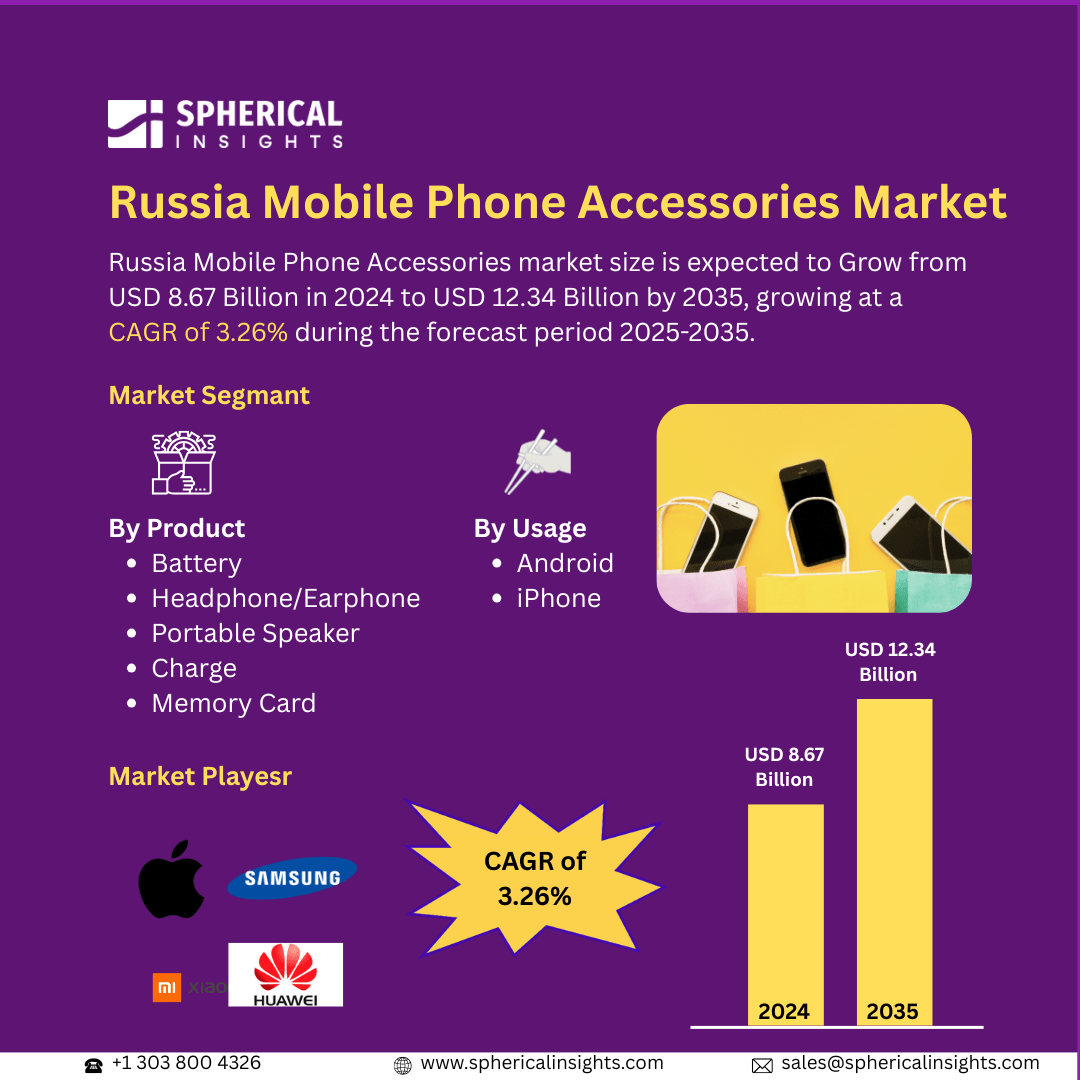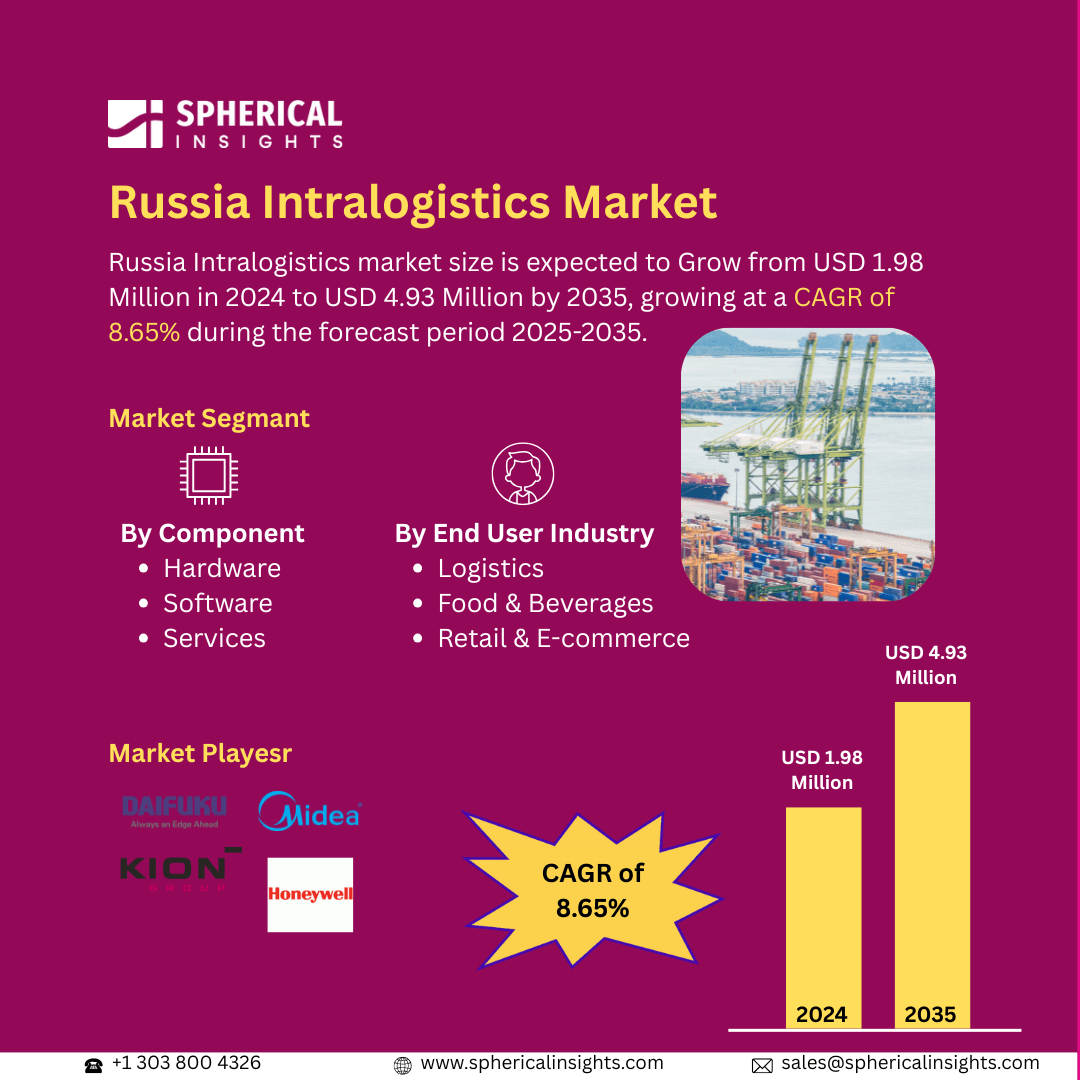Antithrombin Market Summary
The Global Antithrombin Market Size Was Estimated at USD 630.2 Million in 2024 and is Projected to Reach USD 1066.4 Million by 2035, Growing at a CAGR of 4.9% from 2025 to 2035. The growing prevalence of thromboembolic disorders, the growing need for anticoagulant treatments, the development of recombinant antithrombin, the growing awareness of hereditary antithrombin deficiency, and the expansion of healthcare infrastructure worldwide are the main factors propelling the antithrombin market.
Key Regional and Segment-Wise Insights
- In 2024, the North American Antithrombin Market Size held the largest revenue share of 34.6% and dominated the global market.
- In 2024, the therapeutics segment held the highest revenue share of 69.4% and dominated the global market by application.
- With the biggest revenue share of 59.75% in 2024, the human segment led the worldwide Antithrombin Market by source.
Global Market Forecast and Revenue Outlook
- 2024 Market Size: USD 630.2 Million
- 2035 Projected Market Size: USD 1066.4 Million
- CAGR (2025-2035): 4.9%
- North America: Largest market in 2024
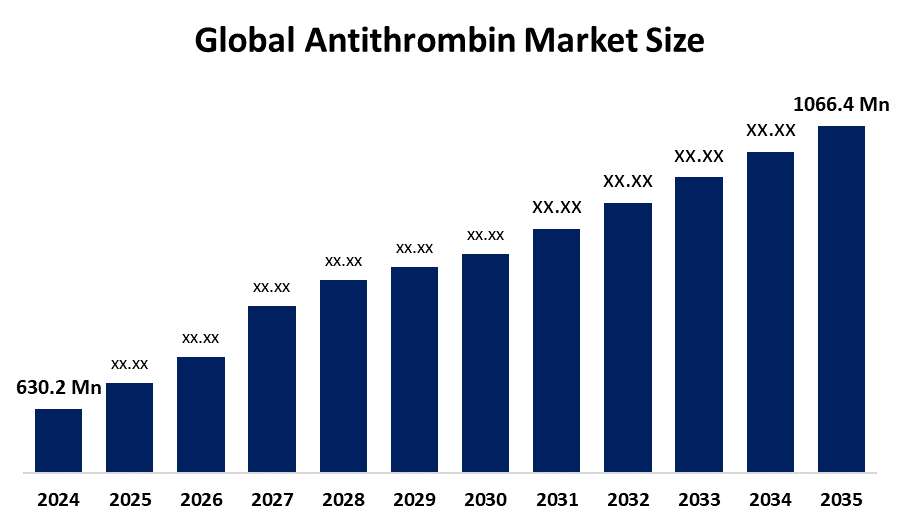
The market for antithrombin consists of products and medical solutions which regulate blood clotting to treat and stop thromboembolic diseases. The body needs antithrombin as a natural blood thinner because it stops blood clots from forming, but people who have inherited or developed antithrombin deficiency face dangerous conditions such as disseminated intravascular coagulation, pulmonary embolism, and deep vein thrombosis. The market growth depends on three primary elements, which include the rising genetic antithrombin deficiency cases, cardiovascular disease rates, and expanding knowledge about anticoagulant treatment. The worldwide market growth receives support from three essential elements, which include the expanding senior population, the increasing number of surgical procedures, and the rising implementation of clot prevention strategies.
The market for antithrombin has undergone significant changes because of technological advancements in the field. The development of recombinant antithrombin and plasma-derived treatments, and advanced purification methods has led to better safety, enhanced effectiveness, and wider availability. Medical treatments have achieved better results through the development of complex drug delivery systems and advanced medication delivery technologies. The market experiences growth because governments support rare disease management through their programs, genetic antithrombin deficiency research funding, and cardiovascular health promotion initiatives. The antithrombin market experiences global expansion because biotechnology companies join forces with medical facilities and research institutes to speed up innovation and improve patient access.
Application Insights
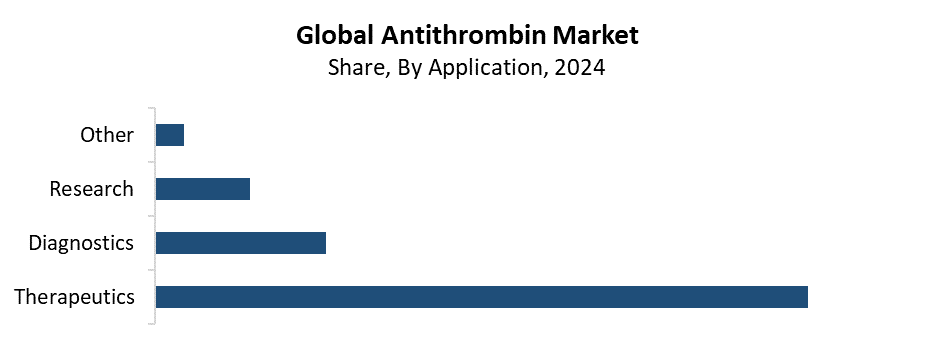
The therapeutics segment led the antithrombin market in 2024 with the largest revenue share of 69.4%. The main reason for this leading position stems from antithrombin serving as a primary treatment for thromboembolic conditions, including disseminated intravascular coagulation, pulmonary embolism, and deep vein thrombosis. People need antithrombin medication to treat their blood clotting problems, which stem from genetic or acquired defects. This treatment helps prevent life-threatening outcomes. The market demand continues to grow because cardiovascular diseases become more common and surgical procedures increase, while medical professionals gain a better understanding of blood thinner medications. The global antithrombin market maintains its lead position because of new recombinant and plasma-derived antithrombin medicines, which provide better safety and enhanced therapeutic results.
The diagnostics segment of the antithrombin market is expected to grow at a significant rate during the forecast period. The market expansion occurs because healthcare providers need to identify and track thromboembolic diseases and antithrombin deficiencies, from the start to stop deadly blood clots in the lungs and deep veins. The development of immunoassays and genetic testing, and point-of-care devices has enabled quick and precise antithrombin testing through improved diagnostic technology. The diagnostics segment of the global antithrombin market experiences rapid expansion because laboratories receive more funding, while patients and healthcare providers recognise the importance of regular monitoring and early detection.
Source Insights
The human segment held the largest revenue share of 59.75% during 2024 and led the antithrombin market. The main cause of this dominance is the extensive use of plasma-derived antithrombin, which is made from human blood and is very successful in treating inherited antithrombin deficits and thromboembolic illnesses. The medical community supports plasma-derived antithrombin as a recommended treatment because it has proven safe and effective in clinical settings. The increasing rates of cardiovascular diseases, surgical procedures, and expanding anticoagulant therapy knowledge drive up the demand for human-sourced antithrombin. The segment keeps its leading position in the global antithrombin market because of regulatory approvals and strict quality control procedures. Better plasma fractionation methods also contribute.
The recombinant goat milk segment is expected to grow at a significant rate during the forecast period. The development of recombinant antithrombin production through genetically modified goats has made plasma-derived products more affordable and widely available through biotechnology advancements. The production of recombinant antithrombin provides a solution to human-derived antithrombin problems because it delivers a pure substance with reduced pathogen transmission risks and constant availability. The development of the market segments continues because people understand recombinant medicines better, while their therapeutic applications expand, and research efforts persist to enhance production outcomes and treatment performance. The global market for recombinant goat milk-derived antithrombin continues to expand because regulatory systems support biopharmaceutical development, and investors show increasing interest in this field.
Regional Insights
North America leads the global antithrombin market with the largest revenue share of 41.3% in 2024. The high incidence of thromboembolic illnesses, general knowledge of genetic antithrombin deficiency, and a strong healthcare system are the main factors driving this leadership. The region's market position is further reinforced by early acceptance of novel treatment procedures, simple availability of plasma-derived and recombinant antithrombin treatments, and state-of-the-art diagnostic facilities. The market growth continues because of strong healthcare budget allocations, favourable reimbursement systems, and ongoing research and development activities. North America leads the global antithrombin industry because it houses major pharmaceutical and biotechnology companies. It receives government support for rare disease treatment and conducts anticoagulant therapy awareness programs.
Europe Antithrombin Market Trends
The European antithrombin market generated a substantial revenue share in 2024 because thromboembolic diseases, together with inherited antithrombin deficiencies, show increasing prevalence in the region. The healthcare systems of Germany, the United Kingdom, and France enable these countries to deliver significant contributions because they provide advanced diagnostic tools and extensive access to recombinant and plasma-derived antithrombin treatments. The market expands because patients, together with healthcare providers, recognise the need for early detection and proper treatment of coagulation disorders. The market receives support from healthcare spending growth and positive reimbursement policies, as well as ongoing research and development activities in biotechnology and anticoagulant drugs. The global market leadership of Europe in antithrombin depends on its implementation of modern treatment approaches along with established medical protocols.
Asia Pacific Antithrombin Market Trends
The Asia Pacific antithrombin market is expected to grow at the fastest CAGR over the forecasted period because of increasing thromboembolic diseases and genetic antithrombin deficiency occurrences, and better awareness about anticoagulant therapies. The market achieves growth because healthcare facilities keep expanding their infrastructure, while hospital networks keep growing, and medical expenses rise in China, India, and Japan. Patient care now moves faster because of advanced diagnostic technology and the availability of recombinant and plasma-derived antithrombin medicines, and better access to specialised treatment options. The region experiences fast growth as the Asia Pacific becomes a rapidly expanding global market. This is because of government programs that support research funding and public education about early detection and treatment.
Key Antithrombin Companies:
The following are the leading companies in the antithrombin market. These companies collectively hold the largest market share and dictate industry trends.
- CS
- Thermo Fisher Scientific Inc.
- ENDPOINT HEALTH, INC.
- Octapharma AG
- LFB
- Siemens Healthineers AG
- Takeda Pharmaceutical Company Limited.
- Grifols, S.A.
- Medix Biochemica
- Others
Recent Developments
- In March 2025, the FDA authorised Qfitlia (fitusiran) for routine prophylactic use in individuals with hemophilia A or B who are 12 years of age or older, whether or not they are taking inhibitors.
Market Segment
This study forecasts revenue at global, regional, and country levels from 2020 to 2035. Decision Advisors has segmented the antithrombin market based on the below-mentioned segments:
Global Antithrombin Market, By Application
- Therapeutics
- Diagnostics
- Research
- Other
Global Antithrombin Market, By Source
- Human
- Recombinant Goat Milk
- Others
Global Antithrombin Market, By Regional Analysis
- North America
- Europe
- Germany
- UK
- France
- Italy
- Spain
- Russia
- Rest of Europe
- Asia Pacific
- China
- Japan
- India
- South Korea
- Australia
- Rest of Asia Pacific
- South America
- Brazil
- Argentina
- Rest of South America
- Middle East & Africa
- UAE
- Saudi Arabia
- Qatar
- South Africa
- Rest of the Middle East & Africa
